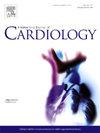Anatomical suitability and clinical outcomes of transcatheter edge-to-edge repair in Chinese patients with significant mitral regurgitation: A real-world echocardiographic study
IF 3.2
2区 医学
Q2 CARDIAC & CARDIOVASCULAR SYSTEMS
引用次数: 0
Abstract
Background
Data on mitral valve transcatheter edge-to-edge repair (M-TEER) in Asian patients are limited. This study evaluates the anatomical suitability and clinical efficacy of M-TEER in Chinese patients with moderate-to-severe or severe mitral regurgitation (MR).
Methods
This study included symptomatic patients with moderate-to-severe or severe MR who underwent M-TEER echocardiographic screening at Fuwai Hospital from January 2021 to February 2024. Patients were classified according to current anatomical criteria for M-TEER. Clinical characteristics, echocardiographic parameters, and treatments were summarized, focusing on the procedural success of M-TEER and 1-year MR recurrence rates.
Results
A total of 481 patients were enrolled, including 304 with degenerative MR (DMR) and 150 with functional MR (FMR). The average age was 68.81 years, 44.28 % were female, and 70.69 % had severe MR. DMR patients had smaller absolute left atrial and ventricular diameters compared to FMR patients. Ideal, suitable, challenging, and impossible M-TEER anatomy was found in 23.49 %, 36.17 %, 13.93 %, and 26.4 % of patients, respectively. Among those who underwent M-TEER, these proportions were 36 %, 46 %, 15 %, and 3 %. The 1-year cumulative incidence of MR recurrence was similar between different etiologies but significantly lower in patients with ideal/suitable anatomy compared to those with challenging/impossible anatomy (5.28 % vs 11.86 %, P = 0.003). Multivariable analysis showed that a leaflet-to-annulus index <1.2 was associated with approximately a 5.8-fold increased risk of MR recurrence within one year.
Conclusion
Among patients with significant MR, 59.66 % had ideal/suitable M-TEER anatomy, but only 48 % received treatment, indicating potential undertreatment. Patients with ideal/feasible anatomy had higher procedural success rates and lower recurrence risks.
中国二尖瓣严重返流患者经导管边缘到边缘修复的解剖适应性和临床结果:一项真实世界的超声心动图研究
亚洲患者二尖瓣经导管边缘到边缘修复(M-TEER)的数据有限。本研究评估M-TEER在中国中重度或重度二尖瓣反流(MR)患者中的解剖学适用性和临床疗效。方法本研究纳入了2021年1月至2024年2月在阜外医院接受M-TEER超声心动图筛查的中重度或重度MR症状患者。根据目前M-TEER的解剖标准对患者进行分类。总结临床特点、超声心动图参数和治疗方法,重点分析M-TEER手术成功率和1年MR复发率。结果共纳入481例患者,其中退行性MR (DMR) 304例,功能性MR (FMR) 150例。平均年龄68.81岁,44.28%为女性,70.69%为严重mr患者,DMR患者的左心房和心室绝对直径小于FMR患者。理想、合适、挑战和不可能的M-TEER解剖分别为23.49%、36.17%、13.93%和26.4%。在接受M-TEER的患者中,这一比例分别为36%、46%、15%和3%。不同病因的1年累积MR复发率相似,但理想/合适解剖结构的患者明显低于具有挑战性/不可能解剖结构的患者(5.28% vs 11.86%, P = 0.003)。多变量分析显示,小叶到环指数(lt;1.2)与一年内MR复发风险增加约5.8倍相关。结论在明显MR的患者中,59.66%的患者具有理想/合适的M-TEER解剖结构,但只有48%的患者接受了治疗,可能存在治疗不足的情况。解剖结构理想/可行的患者手术成功率高,复发风险低。
本文章由计算机程序翻译,如有差异,请以英文原文为准。
求助全文
约1分钟内获得全文
求助全文
来源期刊

International journal of cardiology
医学-心血管系统
CiteScore
6.80
自引率
5.70%
发文量
758
审稿时长
44 days
期刊介绍:
The International Journal of Cardiology is devoted to cardiology in the broadest sense. Both basic research and clinical papers can be submitted. The journal serves the interest of both practicing clinicians and researchers.
In addition to original papers, we are launching a range of new manuscript types, including Consensus and Position Papers, Systematic Reviews, Meta-analyses, and Short communications. Case reports are no longer acceptable. Controversial techniques, issues on health policy and social medicine are discussed and serve as useful tools for encouraging debate.
 求助内容:
求助内容: 应助结果提醒方式:
应助结果提醒方式:


